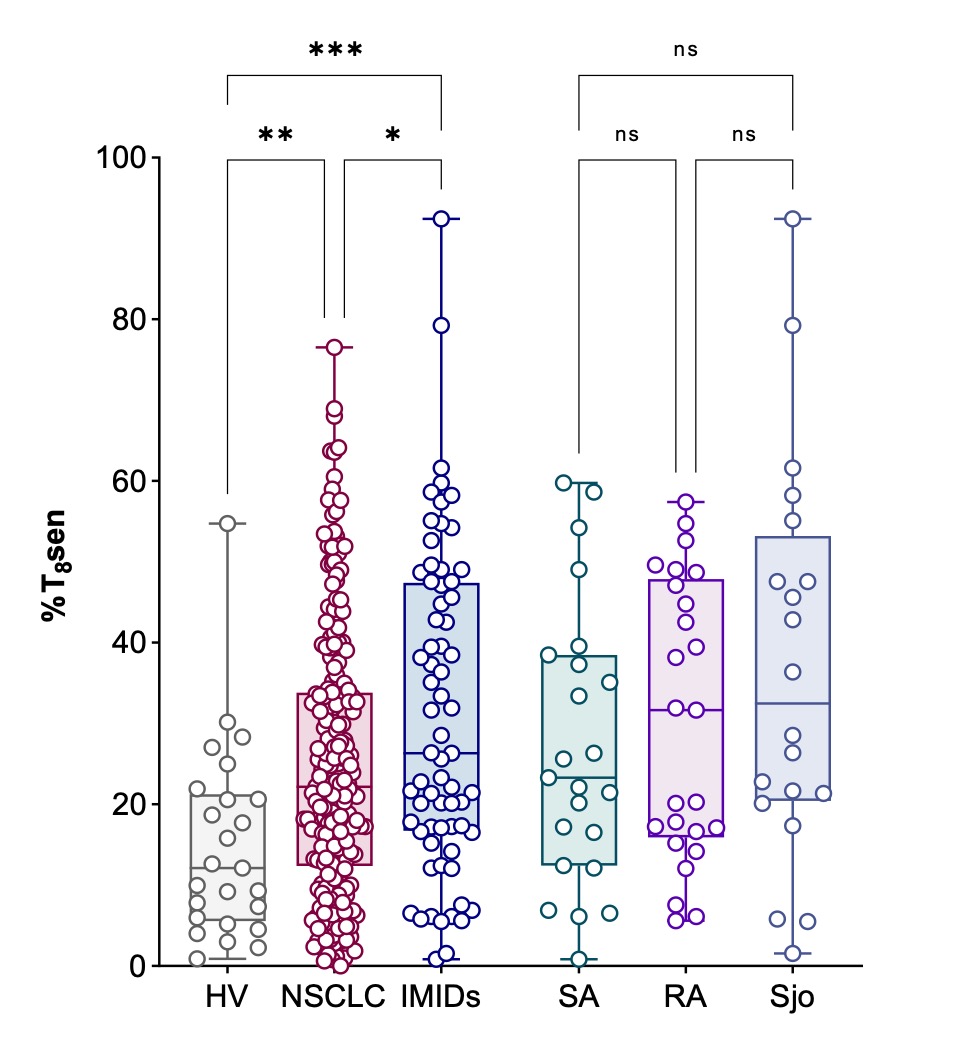Session Information
Date: Sunday, November 12, 2023
Title: (0066–0095) T Cell Biology & Targets in Autoimmune & Inflammatory Disease Poster
Session Type: Poster Session A
Session Time: 9:00AM-11:00AM
Background/Purpose: Immunosenescence is a global remodeling of immune functions that has been first described with aging. It can also occur in pathologies associated with chronic antigenic stimulation and notably cancer. High proportion of circulating senescent CD8+ T cells (T8sen, CD3+CD8+CD28-CD57+KLRG1+ cells) is observed in more than 25% of the patients with advanced non–small cell lung cancer (aNSCLC) and has been associated with resistance to immune checkpoint blockers. The mechanisms leading to accumulation of T8sen are still only partially understood. Chronic inflammation is a potential driver. Here we sought to assess the level of T8sen in patients with IMIDs, its dynamic under TNF inhibitors (TNFi) and the link with the plasmatic concentration of different cytokines.
Methods: T8sen have been identified by flow-cytometry on fresh whole blood samples from 68 patients with IMIDs [25 with rheumatoid arthritis (RA), 23 with spondyloarthritis (SA) and 20 with Sjogren disease (Sjo], 228 patients aNSCLC and 25 healthy volunteers (HV). Patients with RA and SA were evaluated at baseline and 3 months after TNFi initiation. Baseline plasmatic concentrations of IFNα2a, IFN-β, IFNγ, IFNλ1, and IP-10 were quantified using MSD technology. Associations between proportions of T8sen and categorical or continuous variables were performed by Mann–Whitney test and Pearson coefficient, respectively.
Results: Patients with IMIDs harbor higher levels of T8sen compared to aNSCLC patients and HV (Figure 1 left panel). The median level [Q1-Q3] of T8sen was of 26.34% [16.75-47.33] in IMIDS patients compared to 22.18% [12.41-33.84] in aNSCLC patients and 12.11% [5.56-21.28] in HV. Among the three IMIDs, T8sen rates were higher in patients with Sjo (Figure 1, right panel). We did not observe any significant correlation between T8sen and diseases characteristics at baseline. Importantly, TNFi initiation did not modulate T8sen levels in RA and SA patients. Interestingly, we observed significant positive correlations between plasmatic IFN- λ1, IFN- γ and IP-10 with the levels of T8sen (Figure 2).
Conclusion: Patients with IMIDs exhibit high levels of T8sen cells that exceed those observed in patients with lung cancer. This senescence is not altered under TNFi treatment and appears to be primarily driven by IFNs. The link between T8sen and the evolution of the disease as well as with the response to treatment remains to be evaluated. Likewise, since T8sen is mainly driven by IFNs, it would be important to evaluate the effect of anti-IFN treatments and JAK inhibitors on senescence with potential implications in autoimmunity and cancer.
To cite this abstract in AMA style:
Naingeon M, Bitoun S, roulleaux Dugage M, de Oliveira C, Berthot C, Mariette X, Chaput N, Nocturne G. Circulating T-cell Immunosenescence Is High in Patients with Immune-Mediated Inflammatory Diseases (IMIDs) and Is Associated with Interferons [abstract]. Arthritis Rheumatol. 2023; 75 (suppl 9). https://acrabstracts.org/abstract/circulating-t-cell-immunosenescence-is-high-in-patients-with-immune-mediated-inflammatory-diseases-imids-and-is-associated-with-interferons/. Accessed .« Back to ACR Convergence 2023
ACR Meeting Abstracts - https://acrabstracts.org/abstract/circulating-t-cell-immunosenescence-is-high-in-patients-with-immune-mediated-inflammatory-diseases-imids-and-is-associated-with-interferons/


